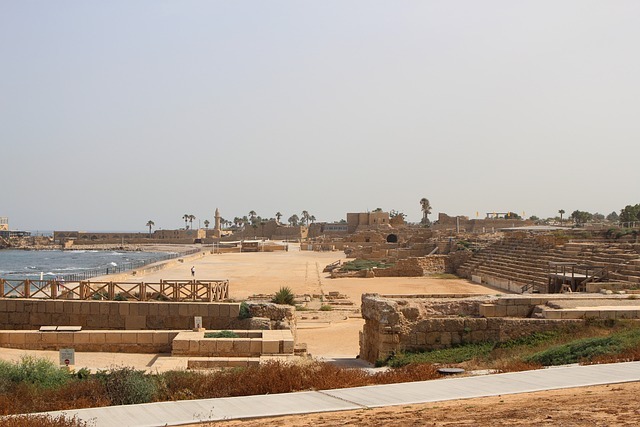CAESAREA FIELD REPORT PART 7
Remains from the Byzantine time
We are now leaving Herod’s Caesarea (will look for more remains of Herod later), and move 500 years forward. We are introduced to another important general rule regarding excavations: what is higher is later in history. Here it would be from the Byzantine time.
We are walking toward a heightened podium from the 6th century CE, into the large bath-house and spa of the Byzantine city which was built or renovated from the Roman bath that had been built by Herod. While the walls are from the Byzantine time, the baths themselves are from Roman times.
In Jerusalem near Binjamei Ha’uma excavators found a Roman factory which produced small pillars and tubes of ceramics and other utensils needed to build bath houses. Parts of the factory can be visited today in the basement of the Binjanei Ha’uma.
We visit the large area that covers the bath-house and ancient “spa”.
Later the Ottomans adapted and adopted the idea of bathing (Turkish baths!)
IV.6. The Bath House
The Bath House was an invention of the Roman culture and didn’t just serve the hygiene but was also an institution where one met and socialized and relaxed. Sand-like material and oil was used to wash the body and to soften the skin – very much like in a modern health-club. There were also bath-tubs to immerse oneself and hot rooms.
Still the main purpose was to socialize, to get together, walk around, do business. There was an entrance fee. (There were different bath-houses for the less fortunate (=less rich).
In the Talmud the Rabbis discussed whether Jews were allowed to go to the bath-house or not. The problem was the statues found there. The Rabbis ruled in favor: after all, the statue is there to please us, not for us to worship them …). The bath itself was constructed in a very sophisticated, complicated way. It had a double floor that was kept apart with dozens of approx. 30 cm high pottery-pipes. (Imagine two boxes, a smaller one inside a bigger one, and the smaller kept “afloat” on small pillars). Hot air was produced outside in furnaces and then blown through a gap in the wall into the space between the two floors, thus heating the water above the second floor. Signs of the original pipes are still visible on the walls. There were also wet and dry saunas. In order to walk on the very hot floors cold water was poured on them.
Bathers did not immerse themselves immediately into the hot water but acclimatized slowly: first they traversed the frigidarium (cold), then the tepidarium (tepid), before entering the water of the cauldarium (hot).
North of the baths we find what we could describe as an ancient “fitness club and the beauty center”. (Today, the Romans would surely add a cafeteria!)
IV.7. The Cardo and the Decamanos
Adjacent to those buildings was a private house, then we come to the “shopping arcade” of the Romans (cardo), crossed by another street. All Roman cities had a similar layout and street-system. They were built as “blocks”, comparable to Manhattan, the blocks were called “insula”. Each block was dedicated to a particular function, be it bathing, living, shopping, or storage. The north-south-axis was the cardo, the east-west-axis was the decomanus. The pavement of the streets are from Byzantine times, but they were built on the same place where older, Roman streets were located. The excavators removed the pavement and discovered older (Roman) roads underneath. In some parts the original street was reconstructed. Herod’s layout of the streets was kept by later rulers; just the level was raised up. There are many more streets that are waiting to be excavated.
Below us we see the great imperial storage (porea) that was used to store wheat and barley, wine and other storable goods.
We are now approaching the center of the city, which was the financial center.
Caesarea was the first local financial center, and later the Byzantines built on the ruins of the Roman period their own financial center.
During the Roman period, those buildings had two barrel vaulted floors, on the ground level being the offices for the employees; the more important managers were located on the second level.
The buildings were very beautiful, with mosaic floors and great halls.
On the sidewalks of the main road, we can imagine Romans discussing their tax issues, the hoarse-races, the latest gossip.…
We look down at the corridors of the vaults beneath us, the archives. The state of preservation is quite impressive, considering that they are 1800 years old. The whole area was used in the Roman era for the procurator and his entourage. The governor would be sitting in the palace. In Byzantine times, they would re-fortify the walls, build the moat, thus destroying several Roman buildings and walls, since the moat had to be dug pretty deep and the awareness of preservation had not been established until 1500 years later.
We can see the vaults that support the structures above them.
There were several synagogues in Herod’s time and throughout later times, but no remains were found in Caesarea (so far, anyway). The synagogue that was excavated in the north of the city is from the Talmudic period.
We continue through an un-excavated area of the Byzantine city, through which we can have a glimpse of the second hippodrome to the right (east) with its obelisk.
2 pm – 2.45 pm: Lunch-break at a mall of kibbutz Dor Akiva.
Afterword: I can highly recommend having a wonderful food break inside the national park. There are some excellent restaurants located close to the sea, with appropriate views. They include pasta for dairy food lovers, and a nearby meat restaurant. Both carry kosher certificates. In addition snacks are also available in the general harbor vicinity. If you want to keep the kids occupied some of the interactive attractions found in the park are guaranteed to not only keep them engaged but also provide a great educational experience! There are toilet facilities, mainly around the main entrance complex. I would strongly recommend taking advantage of them before deciding to stroll through the site, as it can be quite a distance. Being close to the water has the added benefit of a relaxing sea breeze, but please keep an eye on the local weather forecast as some parts of the year can endure brutal heat conditions. That brings me to a must remember: Always, get hydrated before getting dehydrated. It’s easy to get carried away with the delight of being in Israel and the excitement of visiting any famous site. However, this can also lead to forgetting basic safety concerns, and drinking plenty of water is high on the list! Sun hats, skin protection, sun glasses etc. are also important items to bring with you. But once you get into a sensible routine the golden rule is to have plenty of fun! So make sure you have any device that can take those family memories, and don’t forget to smile for the camera!
Our tour guide course will now take us to the next destination:
Ralli-museum of Art (for an excellent model and artifacts of Caesarea) –Winter only open Fri-Sat; From March – open every day from 10:30-15:30 except for Sunday and Wednesday (Tel: 04-636 05 88/04-626 1013)


